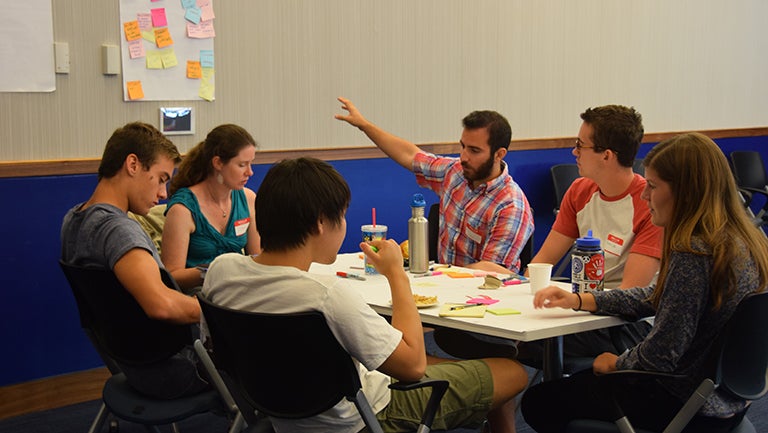Title: Students Work to Shape Innovative Sustainability Solutions for Georgetown
Students and faculty and staff advisors explore how to make the Georgetown campus more sustainable during an all-day workshop sponsored by the university’s student association, the Beeck Center for Social Impact and Innovation, and the Office of Sustainability.

About two-dozen students explored how to make the Georgetown campus more sustainable during an all-day workshop sponsored by the university’s student association, the Beeck Center for Social Impact and Innovation, and the Office of Sustainability.
Building on work with architect and author Bill McDonough last month, Friday’s Sustainability Visioning Workshop leveraged the expertise of a California firm called SMALLIFY founded by David Viotti (C’92, L’98) in engaging students and others to design actionable solutions for the university’s physical footprint and campus operations.
The name of firm refers to the goal of breaking large, sometimes overwhelming goals into smaller and doable ones.
Ambitious Agenda
“The goal is to be as ambitious as possible,” said Chris Augostini, senior vice president and chief operating officer, before the students got to work. “The goal we ought have for next Earth Day 2016, selectively as a body [is to put] forward a very ambitious agenda for this entire community.”
Lisa Gans, the SMALLIFY facilitator and a Beeck Center Fellow, talked to the participants about “rapid innovation” and making small bets that are “affordable losses.”
She gave the example of architect Frank Gehry who she says uses inexpensive paper bags to design building until he settles on a design worth pursuing with more elaborate and expensive models.
“Prototypes are powerful because they provide you and your end user a ‘near-life’ experience to evaluate your idea before you spend time and money developing it,” Gans explains. “No amount of talking about ideas or power point can achieve this as well as prototypes. If the concept looks promising, you can move on to deeper prototypes. If it looks like a loser, it’s just a concept.”
Energy, Water, Waste
Gans also talked about the importance of prototyping an idea, “be it a physical object they’d like to create or a program or plan they’d like to develop.”
Students representing a diverse set of students clubs and organizations across campus worked side-by-side with faculty and staff advisors to explore sustainable options for energy, water and material waste during the workshop.
One group challenged themselves to reduce amount of material waste thrown away on campus, and determined that one of the most visibly wasteful activities on campus are student move-ins move-outs.
Using SMALLIFY protoyping techniques to foster creativity, they created a storyboard out of pipe cleaners, lollipops, tin-foil and other bright materials to visualize a plan for a more sustainable move-in and move-out process.
Rapid Innovation
“Not only will it help [reduce waste] it would create more equity on campus by making cost-effective items that people, especially first year students, can purchase instead of having to buy expensive new items,” said Caroline James (C’16), a government major and environmental studies minor.
The group decided to look into the costs of storing items over the summer, getting students involved, and researching if students would actually purchase used items, what might be most popular, and how to get the word out to first-year students and their families.
Looking Forward
The best solutions will be selected in partnership with staff, faculty, and university leaders over the coming academic year for future action.
“This is a great example of putting our values into action,” said Joseph Ferrara, DeGioia’s chief of staff, who quoted from Pope Francis’ recent encyclical on climate change and the environment. “As a Jesuit institution we are called to engage positively in our world and try to make a positive difference.”